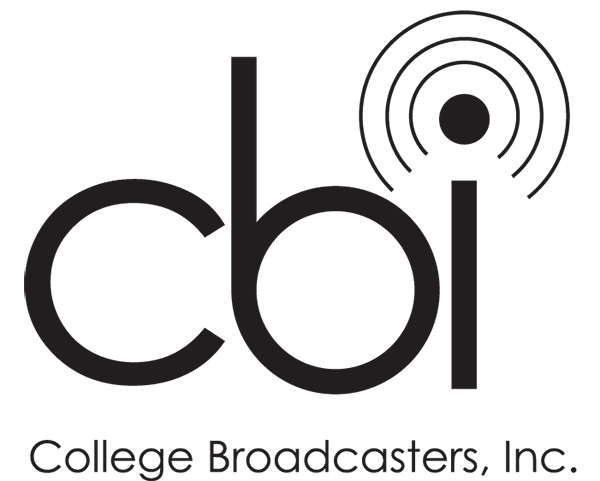Copyrights Basics for Radio Stations & Webcasters
The issues surrounding copyrights can often be confusing, particularly for college and high school radio stations. This website and its content, unless otherwise indicated, is created by CBI volunteers, not attorneys. Our organization, however, has been intimately involved with the process of establishing copyright rates and terms through negotiations and participation in the rate setting process. With this in mind, we will attempt to offer a simple oversight of the issues with links to some of terms covered below. This page is intended to give you general information on the topic but also encourage you to seek more information through sessions at the National Student Electronic Media Convention, the CBI Webinar Series, or through counsel at your institution.
Let’s start with some basics. When it comes to music and radio, whether over the air or the Internet, there are at least two copyrights that are of concern including the musical work and the sound recording. For FCC licensed radio stations not streaming copyrighted music, the only rights involved currently are the musical works (compositions).
Performance Rights Organizations, or PROs, collect fees for the use of musical works by college stations (noncommercial radio stations which are licensed to accredited colleges, universities, or other nonprofit educational institutions and which are not affiliated with National Public Radio). While there are many different PROs, the most established and recognizable to the radio industry are ASCAP, BMI and SESAC. The fees collected by these organizations are set by the Copyright Royalty Board following an arbitration process involving affected parties.
The following schedule of rates for ASCAP and BMI was approved in 2017:
|
Number of full-time students |
2018 |
2019 |
2020 |
2021 |
2022 |
Level 1
Level 2
Level 3
Level 4
Level 5 |
<1,000
1,000–4,999
5,000–9,999
10,000–19,999
20,000 + |
$352
407
557
722
908 |
$359
415
568
736
926 |
$366
423
579
751
945 |
$373
431
591
766
964 |
$380
440
603
781
983 |
Stations with an ERP of 100 watts or less will pay the level one fees regardless of enrollment.
During the same term, SESAC rates increase each year according to an official Cost of Living adjustment or 1.5%, whichever is greater.
Recordings of the musical work, or any other sound, involve another copyright, the sound recording. FCC licensed stations do not need to pay for the use of this right as it has been historically seen as a quid-pro-quo, or a use that returns at least equal value to the copyright owner*. That changes when the station starts webcasting music to which the station has not obtained clearances. Stations need to pay an annual fee which is described in more detail later. There are additional responsibilities placed on the station as well, including requirements to display information about the sound recording, to perform recordkeeping in order to submit reports of use and content restrictions, known as the sound recording performance complement.
Fortunately for college stations the cost associated with the use of musical works in streaming are covered under the institution’s blanket license with the PROs in almost all circumstances (except ASCAP). Unfortunately, the sound recording copyright fees are not. The organization that collects these fees is SoundExchange (“SX”). CBI has been instrumental in negotiating fee structures with SoundExchange that are far less than what the organization originally demanded:
2021: $550
2022: $600
2023: $650
2024: $700
2025: $750
It is important to note that the fees are considered minimum per channel/station. If the station exceeds 159,140 ATH (i.e. the station averages 218 concurrent listeners 24/7) in any month, the station is liable for additional royalties. In addition, if a station offers different music programming on different feeds (“side channels”) that it will need to pay the minimum fee for each feed.
Before we talk about the most recent development, let’s sum this up.
If your station is licensed by the FCC and not webcasting, your station only owes fees to ASCAP, SESAC and BMI. In almost all circumstances, your institution is paying the BMI and SESAC fees, but not the ASCAP fees. This means your station will likely need to pay according to the rate table above fees to ASCAP. You will likely receive a mailing from BMI asking you to log the music played for 3 days. While the regulations require that only a small number of stations complete this log each year, your schools license likely require you to complete these logs.
If your station is webcasting, then you need to pay SX the minimum fee per calendar year in addition to the fees owed to ASCAP.
Another PRO, Global Music Rights (GMR) is among the newest to enter the scene. Many college and high school stations are being invoiced or otherwise contacted by GMR although there is not a fee structure for noncommercial educationally licensed radio stations approved for GMR by the Copyright Royalty Board, so many stations are simply sending $1. However, like other PROs, music licensing is not limited to radio stations, so it’s best to refer inquiries to GMR to an attorney who is knowledgeable about intellectual property.
At this point, we refer you to the 2016 CBI guide to webcasting for Educational Stations, which discusses your options.



